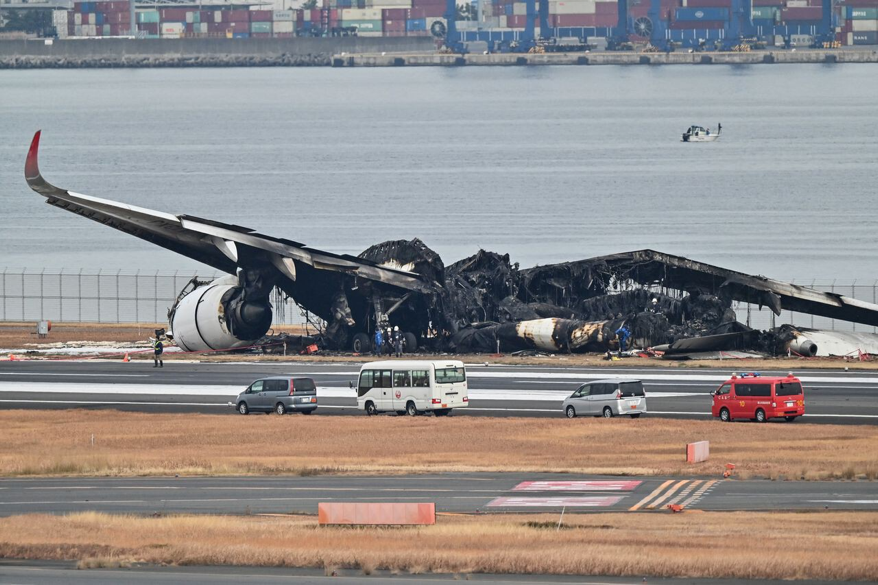Japan Airlines A350 Crash at Tokyo Haneda Airport: A Story of Rapid Response and Survival

In a dramatic turn of events, passengers aboard a Japan Airlines (JAL) flight experienced 18 minutes of sheer terror and confusion, culminating in a miraculous escape from a potential disaster at Tokyo’s Haneda Airport. The incident, which occurred between 5:47 p.m. and 6:05 p.m. last Tuesday Jan. 2, highlights the challenges and unpredictability of aircraft emergencies.
The Japan Airlines Airbus A350-900, registration JA13XJ performing flight JL-516 from Sapporo to Tokyo Haneda (Japan) with 367 passengers and 12 crew, landed on Haneda’s runway 34R at 17:47L (08:47Z) in night time conditions but collided with a Japanese Coast Guard Dash 8-300 registration JA722A (Coast Guard code MA722) on the runway shortly after touchdown and burst into flames.
The pilots of the Japan Airlines jetliner that collided with a Japan Coast Guard aircraft at Tokyo’s Haneda airport told an internal probe that they could not visually confirm the presence of the JCG plane when touching down, according to the company.
The A350 came to a stop down on the runway and was evacuated. All occupants were able to evacuate. The other aircraft carrying 6 people also burst into flames, 5 of the six occupants are confirmed dead. Both aircraft burned down, and 17 occupants of the A350-900 received injuries, the captain of the Dash 8 received serious injuries.
JAL reported their Airbus A350 was carrying 367 passengers (including 8 children) and 12 crew, all of them evacuated from the aircraft. Tokyo’s Metropolitan Police reported 17 occupants of the A350 received injuries.
The ordeal began when a fire broke out in the rear of the Airbus A350, rapidly filling the cabin with smoke and sparking panic among the 367 passengers. Joseph Hayashi, a 28-year-old finance professional from Dallas, recounted the desperate efforts to escape the encroaching flames, as passengers feared an explosion due to the proximity of the jet engines to the fire.

The aviation industry is now keenly focused on how these advanced composite airliners, which have revolutionized long-haul flights and airline economics over the past decade, withstand catastrophic fires. Experts highlight that the safe evacuation of passengers and crew while the aircraft’s structure remained intact could boost confidence in composite materials, despite it being too early for conclusive assessments of the A350’s composite hull’s performance in the fire.
Japan’s Coast Guard reported their Dash 8-300 registration JA722A (Code MA722) was carrying 6 people, the captain was able to evacuate, the other 5 are currently missing. The aircraft was carrying supplies to their Niigata based where the New Year’s Earthquake struck.
Tokyo’s Metropolitan Police reported 5 of the occupants of the Dash 8 are confirmed dead, and Tokyo’s fire department reported, the captain of the DH8C received serious injuries.

Despite aircraft manufacturers’ claims of being able to evacuate a plane in 90 seconds under test conditions, the real-life scenario aboard Flight JL516 was far more complex. Difficulties arose with opening the plane’s doors, a non-functional PA system, and limited availability of evacuation chutes. However, the crew’s training and quick thinking played a crucial role in averting a catastrophe.
AIG is the lead insurance company on the $130mn all-risks policy for the Japan Airlines Airbus A350 plane.
The successful evacuation was a race against time, complicated by passengers’ instinctive but dangerous attempts to retrieve carry-on luggage. Fortunately, the fire did not penetrate the aircraft’s interior immediately, giving passengers and crew precious minutes to escape. Flight attendants, overcoming malfunctioning communication systems, managed to open three of the eight emergency slides, ensuring a safe exit for everyone on board.
Hayashi described the chaos as passengers urged flight attendants to open the doors. Amidst the confusion, his seatmate’s knowledge of emergency procedures proved invaluable. Eventually, the evacuation proceeded smoothly, with passengers heeding instructions to leave behind belongings and remove any potentially hazardous items, like sharp heels.
A team of transport safety officials searched for a voice recorder from the severely burned fuselage of a Japan Airlines A350 plane, seeking crucial information on what caused a collision with a small coast guard plane on the runway at Tokyo’s Haneda airport.
The collision of the Japan Airlines jet with a Japan Coast Guard plane on the runway, which tragically resulted in five fatalities, was a stark reminder of the fragility of life. As passengers like Hayashi and philosophy professor Hiroshi Kaneko, who also survived the ordeal, reflected on their narrow escape, the incident underscored the importance of effective emergency training and protocols in aviation.
Sources: AirGuide Business airguide.info, bing.com, AFP, apple.news
